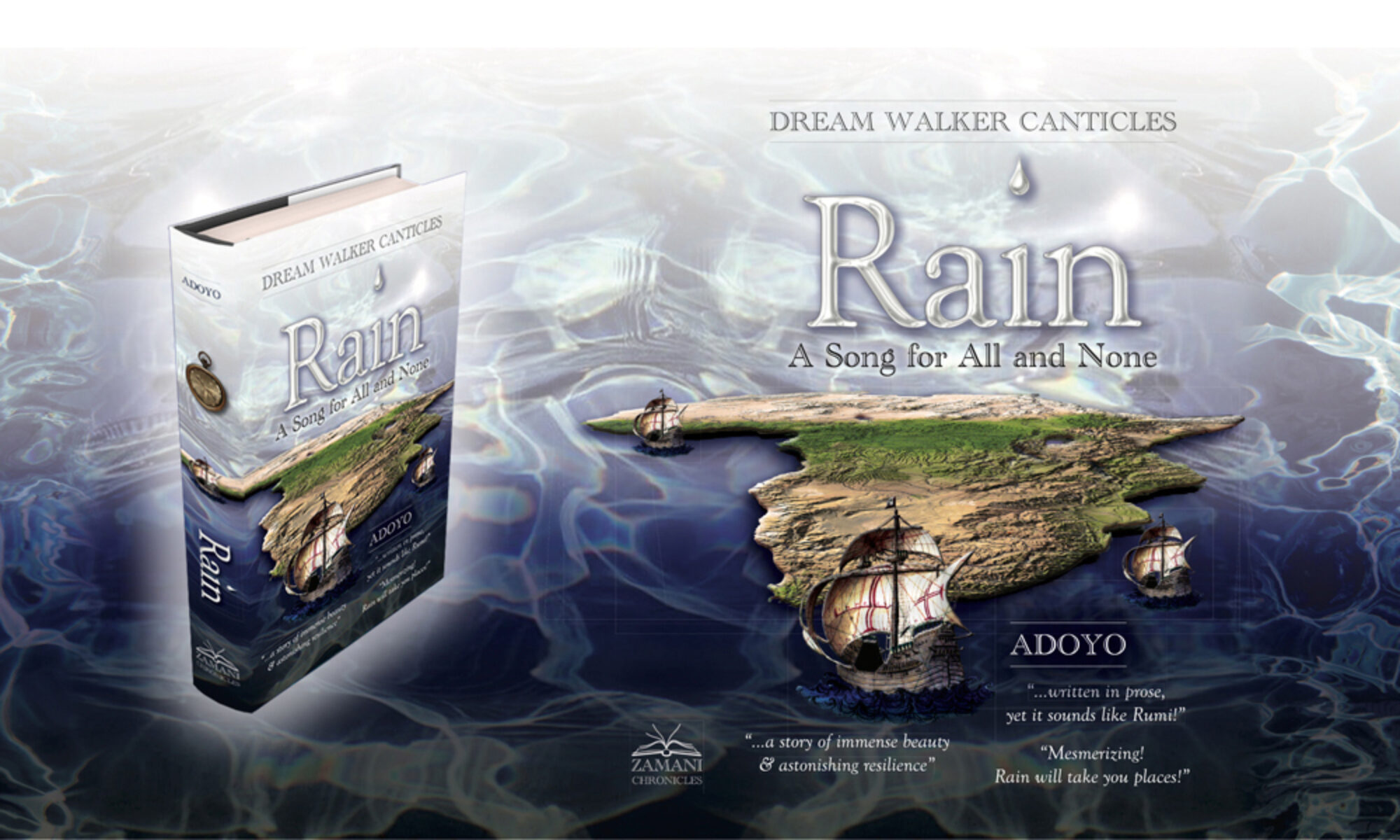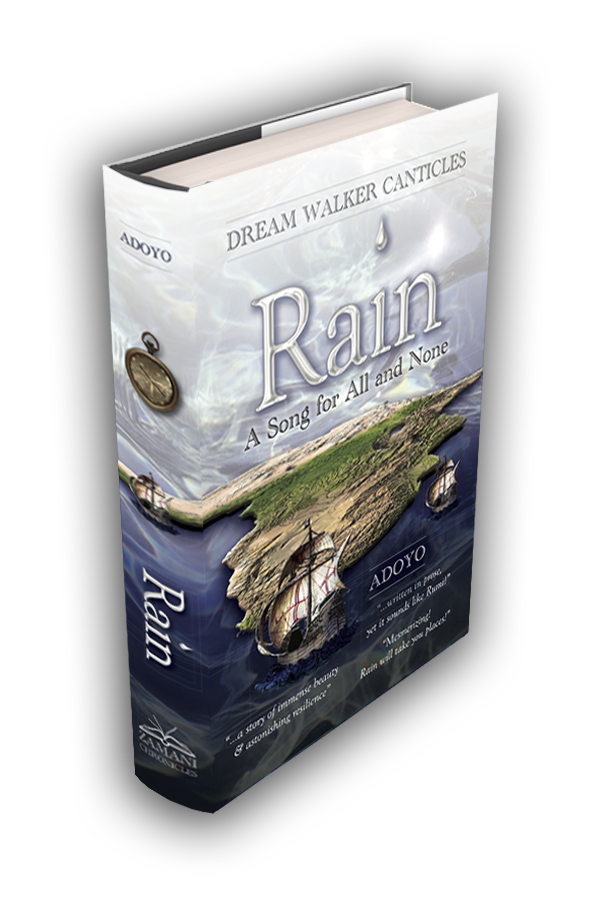by Mary Migliozzi
Rain is a difficult book to describe, and its author seems to know it. “Today someone asked me: ‘So what is RAIN exactly?’ Broadly speaking, RAIN is a poetic meditation on History through Oral Tradition,” she writes on the facebook page of her publisher, Zamani Chronicles. The words “poetic meditation” seem here to be key to any attempt to categorize Rain. The book is not a poem, but it’s also not NOT a poem. The rhythmic quality of its prose is its most distinctive feature, and occasionally even internal rhyme turns the paragraphs on the page into something like verses. It is a long work of fiction in prose, but the word “novel” sits uneasily with Rain, as well. What the novel reader would call “chapters” Adoyo calls “cantos,” and rather than move a linear narrative forward, they fly around in time and space, at times recounting the personal lives of the family at its center, at times accompanying Vasco da Gama on a bloody and distant voyage, at times reflecting at length on the life of a raindrop. I might call it a prose poem, but that’s not really a category that most readers know what to do with. In “A Note to the Reader” at the beginning of the volume, Adoyo writes, “And so I invite you, intrepid Reader, to receive the volume before you with the expansive kindness you would extend to a novel, and the contemplative reflection you would afford a poem.” In other words, let go of your expectations. Stop trying to fit this book into a box, and just sit back and enjoy the ride.
In this sense, Rain asks a lot of its reader: not to turn its pages quickly and easily, not to expect a cinematic or Hulu-friendly reading experience guided by one or even just a few central conflicts and their resolutions. And yet the various books and cantos never feel disconnected from each other; the interconnectedness of its many characters and interwoven stories feels rather like the point. Rain asks its reader to expand her definition of narrative, but it also rewards her for doing so.
So, what is Rain about? It’s a fair but complicated question. At its most basic level, the book is about at least six generations of a family living near the shores of Nam Lolwe, or what you may know as Lake Victoria. Several of its members are Dream Walkers, clairvoyants who move (often involuntarily) in and out of the world of Time, or what we might call this mortal coil. In this way, they can witness events long past and see people long dead or not yet born. They facilitate a connection between a family and their ancestors, especially at the birth of children. The book begins and ends with one Dream Walker, Maya Anyango, whose search for a lost brother and for the meaning of her abilities comes in and out of focus in journeys back and forth through centuries and generations.
On another level, the book is about history and colonialism, about life and continuity, about love that is sometimes physical, sometimes spiritual. It’s about living in a place and time that exists within a larger world and story that we as individuals don’t entirely know. Interestingly and perhaps appropriately, the passage that to me best encapsulates this latter and most significant theme was not a narration of any of Maya’s or anyone else’s adventures through time, but Canto 32, the canto on raindrops:
Vapors carrying echoes of fables from the Arctic, the North and South Seas, the Indian Ocean, the Atlantic, even the Pacific, and the Mid-Earth sea twixt Egypt and the old Roman lands, all meld together in a single bead of dew […] Like every living being, the raindrop’s life begins the moment it condenses, lasts for the length of its descent to the ground, and ends whenever and wherever something breaks its fall. Then it is no longer distinct. Those falling into the soil spread thinly in solitude and soak into it completely, becoming part of something else, no longer the single drop. A different fate awaits those that fall into a river, a lake, or a sea, joining the multitude of their kind. There they meld with other drops, dissolve, and then become part of something greater than themselves, inscrutable where one begins and where another ends.
Rain, the book’s most prominent symbol, is life and death, is past, present, and future. It is a “living being” both distinct and indistinct from all others. Maya struggles to control and make sense of her gift, to find her footing in the world of Time, because she is still coming to understand the paradoxes here embodied. The passage is rather reminiscent of one of Virgil’s lectures in Dante’s Purgatorio, in which the ancient guide conveys the meaning and order of love or sin to an inquisitive and not yet fully spiritually realized Dante.
If Maya is a Dante, she, too, has both a Virgil and a Beatrice, two guides on the journey to spiritual discovery and self-actualization. One central character, the matriarch Akoth, is born on a day when a rainstorm kills her parents, then given a name that means “rain” by the spirit of her Dream Walker father. Akoth lives 111 years, guiding children, grandchildren, and great-grandchildren with an observant and comprehending eye. Maya looks “just like Akoth,” in the words of her great-great-grandfather (words uttered from outside the world of Time) and is in many ways her heir, though she struggles to realize it. Like Beatrice, Akoth sets in motion the journey that Maya will take and helps her see it through to conclusion. Older brother Alex, the lost companion that Maya seeks through much of the book, reflects some characteristics of Beatrice himself (a guide for part of the story and longed-for but distant object through other parts), but he can perhaps more fittingly be seen as her Virgil, one who can carry out the work that Akoth started to lead Maya towards an understanding of herself and her role within and outside of the world of Time.
The author is explicit about her debt to Dante in the Afterword, though she emphasizes a different facet of his influence: “It will not surprise readers familiar with the voice of Dante Alighieri’s Commedia that the Great Poet’s most important animating influence in Rain is the way it emboldens the story to draw back the veil of recorded History and bear witness, with an unflinching and conscientious gaze, to the brutality of the agents of colonial dominion…” Dante was indeed unsparing in his criticism of the political and ecclesiastical powers of the Middle Ages, and Adoyo likewise narrates some of the violence of European colonial powers in nightmarish detail. She also makes clear to her reader that the brutality of a Vasco da Gama did not start and end in his time, but rather becomes an integral part of the story that includes Maya and her family.
As with the objects of Dante’s invectives, though, the colonizers are not granted center stage. Rather, they are repositioned, removed from the pedestal granted them by western narratives of history. This is clear, for instance, in Adoyo’s use of names: the lake whose waters are so central to the book’s symbolism and sense of place is always Lolwe, and the text notes the inappropriateness of the name you’ll find on today’s maps, for an English queen who had nothing to do with it. Adoyo makes clear from her epigraph–a quotation from Chinua Achebe–that she sees her work in the tradition of writers like Achebe and Ngũgĩ wa Thiong’o who have sought through their fiction to counter and reverse the hegemonic European perspective on African history. “Until the lions have their own historians, the history of the hunt will always glorify the hunter,” Achebe wrote. These words open Rain and acknowledge something of the scope and ambition of its project.
In the midst of themes both historical and spiritual, what I admired most in Rain was the imagery and musicality of its prose. Adoyo is attentive to sound in language. On YouTube you can hear her reading canto 32 aloud, and to do so without seeing the pages is to truly question whether this work is a work of poetry or prose. Not only the sound, but the imagery is poetic; she combines the senses, whether creating a sense of hope and calm in describing “hearing the light dance on the water” or a sense of horror and chaos in describing the smells of blood and smoke in other passages. Her language is occasionally even playfully self-aware, as when she describes one character’s name as forming “dactylic tetrameter.” For me, the sense of melody in Adoyo’s writing raises the same question I considered at the start of this review, but it perhaps answers it to a certain extent as well. What IS this book, and how should it best be enjoyed? Is it truly a new or niche genre that will sit uncomfortably with the tastes of today’s novel readers? I think not, actually. I can think of both a very contemporary and a very old-fashioned way to enjoy this book properly: as an audiobook or read aloud and discussed. But however you read Rain, do not neglect its orality.
Find the book here: https://www.zamanichronicles.net/shop/
About the reviewer: Mary Migliozzi, Ph.D. is a Teaching Assistant Professor of Romance Languages & Literature at Villanova University. Her scholarly interests include Italian music and dialect literature. She publishes a blog devoted to humor and non-academic literary discussion, Talking Lit with Aunt Mary.

